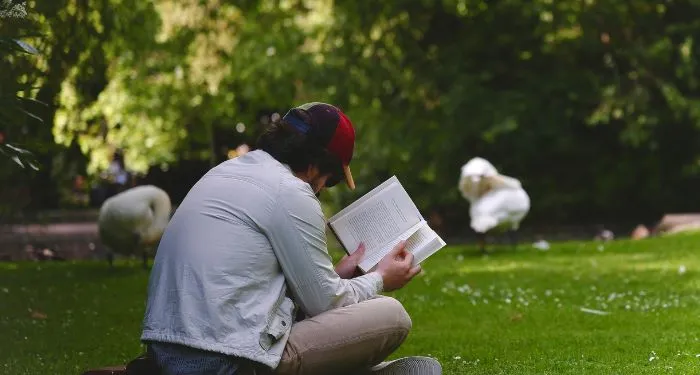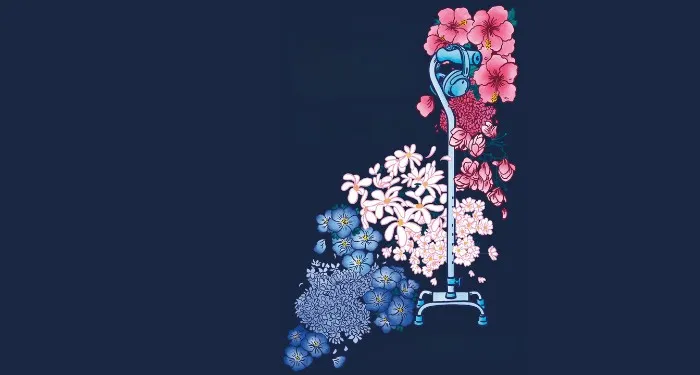Through much of recorded history nomads have been regarded with fear or revulsion by settled peoples. Christian Europe saw their waves of invasion as a God-sent punishment for sins, Asia quaked at the Mongols’ wholesale massacres, and centuries later disgraced Chinese officials, exiled to the nomad-haunted deserts beyond the Great Wall, imagined themselves condemned to a region of barbarians and evil spirits.
It was from settled societies, of course, that reports of the nomads came—they themselves left no written record—and it was from here that the stereotypes congealed: of savage predators or culturally simple wanderers with little technological knowledge, dependent—whether by plunder or taxation—on the wealth of sedentary peoples. Even today “nomads” may be conflated with drifters and vagabonds.
Yet as early as the fifth century BCE the Greek historian Herodotus, in the first extended description of nomads, wrote of the Scythians with awe for their wartime tactics and invincibility:
I do not praise the Scythians in all respects, but in this, the most important: that they have contrived that no one who attacks them can escape, and no one can catch them if they do not want to be found. For when men have no established cities or forts, but are all nomads and mounted archers, not living by tilling the soil but by raising cattle and carrying their dwellings on wagons, how can they not be invincible and unapproachable?
Four centuries later the geographer Strabo recorded that the nomads were honest and frugal and that they demanded only modest tribute from those they dominated, while later Arab historians were impressed by their interest in trade. The fourteenth-century Arab polymath Ibn Khaldun, in his prodigious “introduction” to history, the Muqaddimah, portrayed them as predatory and hostile to sedentary life but free from its corruptions, sturdy, and courageous.
In Europe “barbarian” invasions—Huns, Goths, Alans, Sarmatians—were eventually stilled, absorbed, or repelled. Their racial identities fragmented, although they left their names to two modern nations: Hungary and Bulgaria. But over the past hundred years, with migratory herding sidelined or dying out, the nomadic life began to exert a romantic appeal, fired by an illusion of freedom and equality and liberation from urban constraints. The Bedouin, in particular, however harried and displaced, are still tinged with the romance accorded them by British proponents such as T.E. Lawrence and Wilfred Thesiger.
A gleam of such idealism—and an ingrained restlessness—led the poet and narrative writer Kapka Kassabova to join some of the last migratory pastoralists in Europe on their seasonal ascent to the high pastures in the Pirin Mountains of her native Bulgaria. This was not an epic migration like that of Iran’s Bakhtiari people, for instance, some of whom still trek with their goats and high-packed mules between the Zagros Mountains and the Persian Gulf, but a near-solitary journey with a wayward flock of sheep to rocky uplands and a spartan hut.
She was entering a world of old transhumance, of annual migration, for this was the traditional terrain of the nomadic Karakachans, whose lives were grounded only in the last century. Their unseen presence haunts Kassabova’s latest book, Anima: A Wild Pastoral. Most widely studied in Greece, where their elusiveness—they avoided human habitation and often traveled by night—provoked both curiosity and unease, the Karakachans still inhabit mountainous regions in Bulgaria, Greece, and Albania, but their origins are unknown. They perhaps descend from prehistoric Thracian-Illyrian peoples, who were early Hellenized. Their traditions were austerely patriarchal. Elaborately sashed and kilted, they trekked under huge goat-hair capes so coarse and stiff, one traveler wrote, that a man could almost step out and leave it standing like a sentry box. Their spoken Greek is scattered with words from Homer’s time, to the excitement of anthropologists, and the geometric patterns of their textiles are teasingly reminiscent of those on preclassical Greek vases.
It was their ancient breeds of sheep, dogs, and horses that enticed Kassabova to leave her adopted home in the Scottish Highlands and enter this region—especially the legendary Karakachan dogs that prowl and snarl through the pages of Anima. These dogs’ origins are as complex as the Karakachans’. Their prototypes, it seems, came from the mountains of Central Asia and were perhaps akin to the mastiffs that Pliny the Elder described as fighting lions and elephants.
Two brothers in the Pirin Mountains, Kassabova discovered, had dedicated themselves to breeding these endangered dogs, and she finds them in the derelict mountain village of Orelek, in Bulgaria’s far southwest. Despite the dogs’ intermittent ferocity, she grows to love and individuate the animals more benignly than she does their owners. They are vital to sheep- and goat-herding, and they know the terrain more intimately than any human can. Kassabova writes:
Their eyes were human. They walked with the loose gait of wolves and the puppies were like bear cubs, with expressions so knowing they stopped you in your tracks and made you stare as if into the eyes of an old friend. They were aloof and conscious of it…. To think that these dogs that were more than dogs and at the same time the epitome of dog, would be extinct by now, had it not been for these two brothers was unthinkable. The reason why these dogs were disappearing was because the pastoral ways were disappearing.
In Bulgaria especially the degradation of pastoral life has been brutally swift. The descent of the Iron Curtain severed the timeless tracks between the central Balkans and Greece, and the forced collectivization that followed in the 1950s established large-scale agriculture and livestock breeding that dispossessed the Karakachans of almost all they had. Some forty years later, with the collapse of communism, the state cooperatives disintegrated, and their animals were sold to industrial farms abroad or slaughtered. The migratory life never fully returned.
Kassabova, after she tracked the brothers down, found them despondent and unwelcoming. They had split up bitterly from their chief partner, a local shepherd, several years before. Their world was fraught with jealous rivalries. Kámen, the older brother, remained in half-deserted Orelek, while his younger brother managed dogs in a town upriver, and his solitary hired shepherd roamed the pastures with his flock high above. In these uplands the scattered herdsmen were tough but unreliable, and skilled shepherds grew fewer by the year. In Kassabova’s empathetic account this pastoralism has become the resort of a sad underclass. Many of the herdsmen are survivors of earlier activities: building, mining, logging, stealing. Others were “Gypsies.”
She climbed to their summer pastureland and joined Kámen’s shepherd there. One of the two solitary huts was occupied by an alcoholic cowherd named Vasko: “a skinny young guy with blue eyes discoloured by sadness, or booze,” at once generous and shifty. He cohabited with a fellow cowherd and her small son, on the run from the boy’s violent father. But they soon despaired of Vasko’s drinking and left.
Then there was Kámen’s shepherd, Sásho—“forty-ish and handsome, in a rakish way, his skin full of sun and wind”—whose ramshackle hut perforce becomes Kassabova’s too. Together for weeks they herd six hundred sheep, with eight guardian dogs, a horse, and a foal, returning all of them to shelter at nightfall.
These sheep were not the docile ruminants of milder climes but the ancient Karakachan breed, coarse-coated and half wild. They “would survive the apocalypse and not even notice,” Kassabova writes. Sometimes, drugged on psychotropic false hellebore, they ran amok. If they remained stranded at nightfall their shepherd had to stay with them, or they would fall prey to the ever-hovering wolves. And occasionally, inexplicably, the guardian dogs forgot their charges, regressed to wolfhood, and fell on one another in a bloody tumult.
The mountains here are austerely beautiful, but the tracks between sheep pastures wind up near-vertical slopes of siliceous scree, split by ravines. There is a constant threat of tempests and avalanches. Nightfall brings on the anxiety of counting the homeward flock, of the hut’s walls shaken by storms, and of rocks dislodged by a roving bear. Sometimes Kassabova waits fearfully for Sásho to return after rescuing some stranded or fallen sheep. But “the good shepherd is calm,” she writes:
The good shepherd can take monotony, bad weather, wet clothes, lack of appreciation, dog bites, ulcerated feet, being invisible, having no name, being underpaid, lack of sleep, caring for something that will never belong to him and walking through a beautiful world devoid of humans with just the clothes on his back.
Despite all hardship—and occasionally because of it—Kassabova rejoices. The mountain whose lower slopes she traverses—the 9,560-foot hammerhead of Thunder Peak—becomes a presence at once threatening and sublime. The pine and beech forests shine. The nights blaze with stars. Urban time slips away, so she finds herself repeatedly writing the same half-forgotten date in her diary. Her mobile phone becomes useless. She feels in her element: a person emptied of mundane self, closer to mountains and animals, she writes, “a vessel through which passes the breath of the world.” Hence the “anima” of her book’s title—the Latin word for “soul,” which the Karakachan nomads called “psyche” (pshi-hee), manifest as wind or mist.
But this euphoria is transient, and it is suborned by Kassabova herself. If there is a wishful nomad in the book, it is she. “We have been nowhere forever,” she wrote in an early poem. “We are the ones possessed by arrival.”* She is forever between pastures: “You just get used to something and then you have to go.”
As for Sásho, predictably he falls in love with her—a sympathetic stranger from another world. For her, this is not the first time. Her book opens on a tempestuous relationship over two seasons with a herdsman of Karakachan horses—another pure, wild breed—in the eastern Pirin Mountains. “By sharing his incurable sorrow for a time,” she writes, “I did not alleviate it.”
It becomes the same with Sásho. She depends on his shepherd’s skills, respects his resilience and gentleness, and returns his love. But he drinks. In collusion with Vasko, there are furious bouts that leave him near-mindless. Once she throws his drink back in his face, then fears she’s blinded him. They recover in mutual remorse. He reveals to her piecemeal a life of childhood abandonment, of boyhood vagrancy working in fairs, of petty thieving, of years in jail. His drinking goes on. And on. Implacably she describes their pathetic farewell.
Back in Orelek, she feels both relief and deadness. She rejoins the surly Kámen and helps milk his goats. She does laundry and works on her computer. Kámen’s dog bites her. She speaks with Sásho by erratic mobile phone. She can neither ascend again nor leave the mountain village. But she recognizes this sadness as wider than her own. Earlier, in Orelek, she had witnessed the emptied village’s annual festival, when the past inhabitants returned like ghosts from this dying life. Their gene pool was conflated from all over the Balkans, Asia Minor, and beyond, mixed by centuries-long tides of insurgence and migration. Kassabova writes:
These were the descendants of Orelek paying their respects to their lost homeland. Their parents and grandparents were humiliated, robbed, battered, killed and exiled along with their animals and these orphans came to check up on the old house, check up on the roofless ruin and fill a bucket with figs from the family garden. These were tattered people without teeth, women in black who’d lost husbands and sons and men who worked abroad, remnants of highland clans, the faces of a pastoral civilisation that was only smashed in the last seventy years by the military-industrial complex whose ruins were now everywhere.
The waning of any deep interaction with the natural world is the abiding sadness in Anima. It is less the lament for a wounded earth than for human separation from it, echoed in her own fragmented relationships and lit by the intensity of her writing.
Anima is above all distinguished by Kassabova’s concentration on a region that is little known even to Europeans. The book is the last of a quartet focused on the mountains of southern Bulgaria and North Macedonia where they descend into Greece, and where the Mesta and Strymon Rivers flow southward to the Aegean. For almost half a century this region survived behind the Iron Curtain: a blank on the map in most people’s minds. But Kassabova, born in Sofia in 1973, has given it a voice. It is the country of her native Bulgarian language and childhood, yet it is viewed, after an absence of three decades, through freshened eyes.
Her quartet starts with the beguiling Border: A Journey to the Edge of Europe (2017), a study of the Bulgarian borderlands with Greece and Turkey. Like so many national borders this is a fraught and inglorious one: an old frontier of Iron Curtain grief—Bulgarians and East Germans fleeing south—and now a region where desperate migrants from the Middle East are moving north. In Kassabova’s Soviet-era youth this had been forbidden ground, and she traveled here later with a kind of nostalgic curiosity.
Border is filled with a multitude of transients with whom Kassabova feels an affinity. Refugees, survivors, and opportunists, displaced Greeks, Turks, and Kurds render up their stories to her wholesale: strange, darkly shocking, occasionally comical. And she interweaves these encounters with passages of history, folklore, and myth (much of it classical Greek) that temper the recent past with the afterglow of ancient memory. Curative holy springs survive from remote antiquity; a ghostly web of Roman roads remains.
The second book of Kassabova’s quartet, To the Lake: A Balkan Journey of War and Peace (2020), narrows and intensifies her focus. If you were to fly westward 150 miles from the sheep pastures of Anima you would meet the point where the borders of Albania, Greece, and North Macedonia converge and where the twin lakes of Ohrid and Prespa shine, she writes, “like eyes in an ancient face.”
These lakes are disparate twins. Ohrid is luminously beautiful; Prespa wilder, darker. They are home to a transcultural mélange of peoples and faiths, where the shrine of a Black Madonna can coexist alongside Sufism. This is a region of repeated atrocities and perennial hardship—Ottoman oppression, conflict with Serbia, the forced assimilation of leftover Turks—and Kassabova responds to its inhabitants with adroit and sensitive listening. “All my life,” she writes, “I’d be drawn to people and places that are damaged.” She divulges, too, a deeply ingrained sense of inherited hurt; for this is the land of her maternal ancestry, “a clamorous hinterland of back-story,” imbued especially with the specter of her loved and formidable grandmother, who “ate to excess, smoked heavily, felt deeply, and what she found pleasurable was driven to a point of exquisite pain.” Kassabova writes:
I wanted to know what creates cultural and psychological inheritance, and how we can go forward with it, instead of sleepwalking back into the geopolitical abyss. The abyss is home to the bones of our predecessors who could not escape dark forces. Some of those forces are still with us—they never went away—the better to let us know that the abyss is always open for business.
During her travels for Border, Kassabova encountered a mendicant Belgian botanist compiling an inventory of local mountain plants—“thirty thousand so far, he said.” In the penultimate volume of her project, Elixir: In the Valley at the End of Time (2023), she might be following in his footsteps. Her chosen valley lies in the far south of Bulgaria, where the Mesta River flows into Thracian Greece. This is a region rich in medicinal plants and steeped in their lore. A host of old practices surround them (a healing herb must be asked permission to pluck it), and the foragers’ ecosystem is a map of hard-earned knowledge. But those who harvest these sometimes rare herbs are paid a pittance by international traders, and in the chic health shops of the West their origins often go unacknowledged. As Kassabova writes:
It seems important to know that the passion flower is from France, the slippery elm from the USA, the marigold from Egypt and the rose petals from Pakistan. It makes me curious about the hands and faces, and lives of the people who picked the plants through which I run my own hand.
She describes the herbalists and foragers, especially the oppressed Muslim Pomaks, and finds villages steeped in black magic, sacred rocks and trees, shrines of mystic healing, miracle-working waters. She submits to practitioners of exorcism and divination with rarely a whiff of skepticism and brews alarming plants in her rented room.
One misses the gentle humor of Border. Some readers will plunge willingly into her passionate and engulfing “biophilia,” which she defines as “the human instinct to be one with the rest of nature.” Others may balk at its repeated and near-evangelical insistence. But more importantly, she registers the ecological decline of her remote valley, the destruction of its forests, even its thinning bird life, and gives a rich compendium of the folklore and practices that surround it—not quite the 30,000 species of the Belgian botanist, but a work that sets plants in their human context.
Toward the end of Elixir Kassabova befriends a breeder of Karakachan horses—a lonely, feral man who becomes her companion in a relationship described at the start of Anima, the last of her four-book enterprise. She mentions too, in a chance aside, that she entertains the notion of becoming a shepherd. So she foresees her future.
In this quartet she has raised a bittersweet monument to her native lands, intimate in its knowledge and imbued with a sensibility that reanimates language. An old woman in her Elixir valley tells her, “You have a way with words.” And so she does. Kassabova writes in English, yet describes herself elsewhere as only “a tenant in the English language house.”
Perhaps this sense of fragile tenancy, in language and in life, has been necessary to her work. The people to whom she instinctively relates are transients and outsiders, and the natural world, in its seeming permanence, becomes at once a wild haven and the bedrock of her impassioned books.



















 English (US) ·
English (US) ·